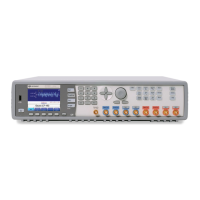Appendix
574
Query the instrument and return a binary block of data containing the
current settings (learn string). You can then send the string back to the
instrument to restore this state at a later time. For proper operation, do not
modify the returned string before sending it to the instrument. The returned
string will contain about 32K characters. Use :SYST:SET to send down
the learn string. See :SYST:SET[?]
Set the “Operation Complete” bit (bit 0) in the Standard Event register after
the previous commands have been completed.
Return “1” to the output buffer after the previous commands have been
completed. Other commands cannot be executed until this command
completes.
Read the installed options. The response consists of any number of fields
separated by commas.
Clear the Standard Event enable register and Status Byte condition register
at power on (*PSC 1). When *PSC 0 is in effect, these two registers are not
cleared at power on. The default is *PSC 1. The *PSC? query returns the
power-on status clear setting. Returns “0” (do not clear at power on) or “1”
(clear at power on).
Recall the instrument state stored in the specified non-volatile storage
location. You cannot recall an instrument state from a storage location that
is empty.
*RCL 1 to 4 recalls a stored instrument setting.
*RCL 0 recalls the default setting.
Reset instrument to its factory default state (refer to “Keysight 81150A /
81160A Factory Default Settings” in section 3.21). This command will abort a
sweep or burst in progress and will re-enable the front-panel display if it
was previously disabled (DISP OFF command).
Store (save) the current instrument state in the specified non-volatile
storage location. Any state previously stored in the same location will be
overwritten (and no error will be generated). There are four locations 1, 2, 3,
4) available.

